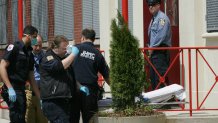Charles Hurd runs a small farm just an hour and 30 minute drive upstate from New York City that sells choose-and-cut Christmas trees. Among the farm's tactics to get people to drive out to the family-owned operation is having Santa Claus skydive onto the farm on Black Friday.
Despite being close to the largest metropolis in the United States, Hurd, 31, has never been able to sell his trees in the Big Apple. Until this year.
“We haven’t gone down because we heard that it was very difficult selling trees in [New York City] and how that works with permitting and that sort of thing,” Hurd said.

New York City's Christmas tree industry is a curious ecosystem, challenging for newcomers to break into. It functions like a “cartel," according to one retailer speaking somewhat facetiously. The industry is dominated by plants from elsewhere, typically high quality Canadian trees, popular North Carolina Fraser Firs — one grower called them the “Cadillac” of Christmas trees — and the Douglas Fir from Oregon.
The market is particularly challenging for small farmers in New York state. The complicated logistics of selling in the city, costly prices of farmland, and notoriously strong competition makes it difficult for farms from New York to find their niche in the market.
Hurd has been able to sell his trees in the city for the first time thanks to recent initiatives begun by the Christmas Tree Farmers Association of New York (CTFANY) in partnership with Grow NYC and the New York State Department of Agriculture and Markets.
While local tree farmers have little chance of taking back the city, the locovore-like initiative hopes to facilitate selling, raise awareness, and promote local trees so that farmers can better take advantage of the lucrative market that's practically in their backyard.
Sourcing Trees Locally
On Saturdays this December, Hurd and his mother Susan have staked out tents at Greenmarkets in Brooklyn Borough Hall and Fort Greene — hauling about a hundred freshly cut Douglas Firs, Concolor Firs, Canaan Firs, Balsams, and Blue Spruces down from their farm in Modena, New York, to split between both locations.
The Greenmarkets, which typically sell locally grown produce and other products from their member farmers, opened their markets in partnership with CTFANY this year to Hurd and another seller, Bob Schoch, who owns Primrose Hill Farm in Staatsburg, New York.

This pilot program offers them a four-week time slot in the market to sell their trees and includes paid help from the Youthmarkets program, as well as tents and tables to ease the logistics.
For the Hurd family, this Greenmarket opportunity was the only way to bring their trees down to the city. According to Susan Hurd, it has “tripled” their business. Charles says his mother is an “optimist.”
They sell their trees for the same amount that they would on their choose-and-cut farm upstate, about $50 to $60 each. Prices at other stands vary around the city depending on the seller and neighborhood.
"Fresh and fragrant is what we’re emphasizing," Susan Hurd said about how they market their trees. They cut the trees the night before coming to market. Trees shipped in from other states take longer to arrive after they are cut.
[NATL] White House Christmas Trees Through the Years
The effort to bring more New York grown trees into the city isn’t limited to the Greenmarkets.
There is also a push for tree sellers who line so many sidewalks across the city for the holiday season to include New York state-grown trees.
Last year, the state’s “Pride of NY” program began supporting wholesale tree farmers to connect them with NYC vendors and help with promotional materials. According to a release, 2,000 trees labeled as originating in New York were brought into the market.
Greg’s Trees, which sells in locations throughout Brooklyn and Queens, is a prominent retailer of New York state grown trees. This year, their stands had sold out of their New York stock by Dec. 9.
George Nash, who has been selling trees in New York state since the 1970s, said there was an “concerted” push to purchase from New York state growers this year. Vendors personally reached out to him, as did the CTFANY.
Nash, who typically buys trees grown in Canada or North Carolina, is considering adding New York trees to the selection in his 17 stands around the city next year.
“Maybe we’ll do some trees [from New York] and make everybody happy,” Nash said.
United Against Fake Trees
Some customers at Hurd’s Greenmarket stand admit that the idea of cutting down a living thing for just a few months seems to be contrary to environmentalism.
“Last year for the first time we considered ‘Should we be doing this? Is there something we can do with the tree afterwards?’” said Stephen Hoogerwerf, 40, a nearby resident, who purchased a Douglas Fir with Chaneve Jaeanniton, 37. “When you start to think about it, it's kind of like, why?”
Frank Banisi, 35, who travelled from Bushwick with Claire Moyle, 29, initially questioned the sustainability of cutting trees down. The pair traveled out of their way for a locally grown tree after receiving an email from a food radio network that talked about the environmental benefits of real, local trees.

Hurd is armed with arguments that his trees are beneficial for the environment. He runs his own composting program for unsold trees and from other agricultural waste around the area. Each of his trees at the Greenmarket bear a tag advertising "Treecycle," part of MulchFest 2016, a NYC Parks initiative to turn Christmas trees to wood chips.
Younger trees create more oxygen than older trees, he also said.
“Older trees are just like people in life, they’re a little more sedentary, they don’t respire quite as much, so its good to keep moving them out," he said.
Despite the apparent rivalries within New York City, the other farmers are quick to note that the real enemy in the competitive market is not each other — but artificial Christmas trees.
According to market research by the National Christmas Tree Association, 13.9 million artificial Christmas trees were purchased in the United States, compared to 26.3 million real trees, in 2014. The numbers have hovered at about the same averages for the past six years.
Amber Cline, whose family owns one of the large wholesale farms in North Carolina, said the real versus fake competition is the prime concern for the industry.
"Ultimately our goal as an industry is to make sure that homes have real Christmas trees," Cline said. "So if they come from the retail lot on the corner that got their trees from North Carolina wholesaler or from the choose-and-cutter outside of town, either one to use is wonderful. We just want them to have a real Christmas tree."
Taking Advantage of the Market
New York state is the 8th largest Christmas producing state, cutting about 270,000 trees in 2012, according to the U.S. Agriculture Census. But that’s far behind the giants of Oregon and North Carolina — numbers one and two — which produce over six million and four million, respectively. Trees from these mass-producing states dominate other markets across the country.
According to Dave Morin from the Massachusetts Christmas Tree Association, “all of the retail lots in Massachusetts have trees shipped in from from out of state.” He estimates that most trees come to the state from Canada, the neighboring states of New Hampshire or Vermont, or shipped up from North Carolina.
In California, according to Sam Minturn, executive director of the California Christmas Tree Association, 90 percent of trees in the state come from elsewhere. Growing in California is difficult for similar reasons as New York -- high land prices and the fact that most farms are small choose-and-cut operations. Trees come mostly from Oregon, which is the largest producer of Christmas trees in the country.
Based on these industry trends, Dave Weill, one of the few New York state farmers who grows tree wholesale, says the tree stock in New York state realistically wouldn't be enough to sustain the New York City market anyway.
"I’m one of the largest growers in the state and I’m only supplying seven vendors in the city. That’s a teeny-tiny amount," Weill said.
As the major New York City retailers mainly deal with wholesalers and large quantities of trees, small farms like Hurd's are less than ideal to purchase from. Nash, for example, deals with roughly 15,000 trees a season, which is more than the entire stock of most tree farms in New York state.
For a retailer like Nash, the decision to buy trees is based on long-term relationships, prices, consistent quality, and changing trends. That's why he typically deals with trees from Canada or North Carolina, even though New York farms also grow some of the same varieties of trees.
"The problem is that nobody has a Fraser Fir like the North Carolina people do," Nash said.
The New York state farmers admittedly have a different perspective. Weill attributes the Fraser's popularity to an "aggressive PR campaign," and Mary Jeanne Packer calls the buyers' bypassing of small farms a "misconception."
"We have some growers who would be glad to sell all their trees at one time to one buyer," Packer said. "The buyer doesn’t want to make that commitment."
As a small farmer making his own way into New York, Hurd has faced his own difficulties in taking advantage of the market. He and his mother like meeting customers and being part of the community, but with a 3 a.m. wake up call, fuel costs from hours of driving, and $120 in tolls, he's questioning whether the trek is worth it.
"I'm not sure we're going to do it again next year," Hurd said. "It's a lot of work for what it is."
When asked if they would come back next year, his mother Susan, however, answered a resounding "yes."
